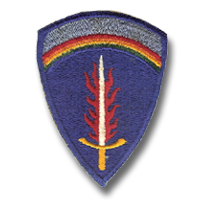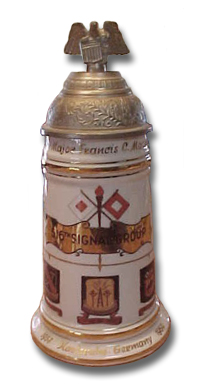| If you do
NOT see the Table of Contents frame to the left of this page, then Click here to open 'USArmyGermany' frameset |
|||||||||||||||||||||||||||||||||
516th Signal Battalion |
|||||||||||||||||||||||||||||||||
|
|
|||||||||||||||||||||||||||||||||
|
|||||||||||||||||||||||||||||||||
|
|
|||||||||||||||||||||||||||||||||
| Group History | |||||||||||||||||||||||||||||||||
| 1954 - 1970 | |||||||||||||||||||||||||||||||||
| (Source: Annual Historical Report - 1957, 516th Signal Group, APO 164) | |||||||||||||||||||||||||||||||||
|
Following
WWII, the 3367th Signal Service Battalion was redesignated as the
516th Signal Service Battalion in Guam. It was re-designated as
the 516th Signal Group in Germany on 10 February 1954. HHD, 516th
Signal Group was located at Neureut Kaserne in Karlsruhe.
The mission of the Group was to support Central Army Group (CENTAG) with tactical communications during command post exercises and maneuvers and in the event of an emergency. In 1957, the 516th comprised the following attached units: |
|||||||||||||||||||||||||||||||||
|
|||||||||||||||||||||||||||||||||
|
The above-listed
units participated in normal and specialized training, operational
missions, and in installing and maintaining fixed-plant communications
facilities when not committed to their primary mission. |
|||||||||||||||||||||||||||||||||
| (1)
The 17th Signal Battalion was reactivated on July 5, 1950 at Karlsruhe,
Germany. It was inactivated September 25, 1965. 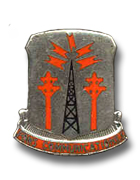 17th
Signal Battalion DUI
17th
Signal Battalion DUI
NOTE: On March 16, 1981, the Battalion was reactivated under the 22nd Signal Brigade at Höchst, Germany, and entrusted with the mission of providing Command and Control Communications to the V Corps (US) Commanding General and subordinate units. In December of 1992 the Battalion moved to its current home on Larson Barracks in Kitzingen, Germany. More about this battalion will be posted in the future on the 17th Signal Battalion Page. |
|||||||||||||||||||||||||||||||||
| (2) Redesignated
15 August 1949 as the 29th Signal Construction Battalion. Allotted to the Regular Army on 31 October 1950. Redesignated 20 October 1953 as the 29th Signal Battalion (Construction). Inactivated 12 August 1963 in France. 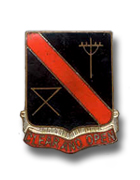 29th
Signal Battalion DUI 29th
Signal Battalion DUI NOTE: More about this battalion will be posted in the future on the 29th Signal Battalion Page. |
|||||||||||||||||||||||||||||||||
| (3) HHD,
447th Sig Bn was located at D'Isley Kaserne, Pirmasens, APO 189, in
1956. The battalion's mission was to support the 516th Signal Gp in the construction and maintenance of various types of wire and cable projects in both germany and France. Also provided support to the 516th on various maneuvers. The battalion was reorganized under TO&E 11-250 on 13 February 1956. 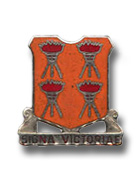 447th Signal Battalion DUI
447th Signal Battalion DUI NOTE: More about this battalion will be posted in the future on the 447th Signal Battalion Page. NOTE: 447th Signal Battalion website contains a very nice Picture Archive from the mid 1950s. |
|||||||||||||||||||||||||||||||||
| (4) See the 6981st Civilian Support Center Page for more historical details on the 6980th and 6981st CLGs. | |||||||||||||||||||||||||||||||||
| If you have more
information on the history or organization of the 516th Sig Gp, please
contact me |
|||||||||||||||||||||||||||||||||
|
|
|||||||||||||||||||||||||||||||||
| 1957 | |||||||||||||||||||||||||||||||||
| (Source: 516th Sig Gp stein, 1957-59 - found on eBay, May 2005) | |||||||||||||||||||||||||||||||||
|
|||||||||||||||||||||||||||||||||
| (Source: Email from David R. Paul) | |||||||||||||||||||||||||||||||||
| I was assigned
to 516th Signal Group in June of 1956 and returned to Conus in July
1957. Honorably discharged as an Sp4, in 1959. I voluntered for the draft in October 1955, took basic training and clerk's school at Camp Chaffee, Arkansas. In March 1956 I was assigned to Repl Co at Fort Leonard Wood and was levyed to Germany in May 1956. I was one of several new privates to arrive at Neureut Kaserne. I will have more information when I review my file copy of orders. I was assigned as S1 clerk and had responsibility for personnel records of the 516th Group, including all enlisted and officer personnel. Captain Poston was adjutant at the time. Lt Mears was assistant adjutant. I also, had responsibility for assembling applications to marry German nationals and section 8 discharges. Eventually, I was responsible for all orders for transportation back to Conus. Not suprisingly, all the Hq detachment personnal from the 516th flew back! Also, I became responsible for all TDY funds and made many trips back and forth to Heidelberg, to coordiante with the DA civilian. I learned quickly about the bureaucratic process of spending all the money before the fiscal year end, so the next year's allocation would not be reduced. As a result many officers (mostly) and a few enlisted went on TDY to Thionville, with side trips to Luxembourg and Paris! I'll stop for now, but I have some other (amusing, at least to us at the time, stories) about my time with the 516th Signal. I stayed in the reserve after returning. The money helped getting through Iowa State. I got a reserve comission in 1962 and retired as a Major in the Adjutant General Corps. Now 68 years old and enjoying the retirement pay and benefits since age 60. David R. Paul |
|||||||||||||||||||||||||||||||||
| (Source: Email from Jim Belden) | |||||||||||||||||||||||||||||||||
| I was drafted and assigned to the 516th Signal Group as a Cryptologist in 1957. During my assignment there I was faced with an unusual opportunity for a Pvt E2. I was assigned to Headquarters Company, as a clerk in S3. Both the Sergeant and the Lieutenant in charge were short timers and were scheduled go back to the States. As such, they were less than interested in managing me! I asked the Lt. what he wanted me to do and was told that we were soon to have an Inspector General's inspection; why didn't I check our records and see if we had completed all of our mandatory training as a Group.
By the time I had completed my report the Lt. was "one foot out the door". I asked what I should do with my findings and he asked me what would I recommend (mind you, I'm a slick sleeve pvt.). I suggested a three day maneuver to include the entire 516th Signal Group, he said fine, write it up! When I had completed my assignment; which included forced marches, bivouack in the boonies, live target shooting, map reading exercises and a bunch of other stuff I can't even remember; the Lt. was gone! I took my work to a Captain Becker; the Headquarters Company S3 officer; who called Major Hoover, the Group S3 officer. I presented my work to them and they both thought it made sense; "OK Belden, let's do it!" They put it into effect almost entirely as I wrote it and; because of my outstanding "soldiering", assigned me to drive the post commander, a Col. Wm. A. Glass Jr, while the maneuver was in effect! Boy, my army buddies didn't like me much after that! I was then reassigned to Post Headquarters to work direct for Major Hoover. This might seem quite trivial but the memory just "wafted" back to me and made me smile. So, for what it's worth................ While assigned to the 516th Signal Group at Neureut Caserne, I needed to get an additional job because my first wife was receiving part of my pay due to an allotment which we agreed to; we were separated when I was drafted; she was to "bank" the money and until I got out of the army. If we were to decide to get back together we'd have a nest egg, if not we'd split up the money. What happened to the money is another story! So I found a job in the post theater, one feature every night and two on Saturday & Sunday. Without the extra money I couldn't go anywhere anyway, so I went to work. I moved from usher to ticket taker to manager within a few months. The theater manager; Nick Dan; that hired me was rotated home. All this while maintaining my "day job" in the army. There were three of us working at the theater plus a German civilian who was the projectionist. Herr Baz spoke no english so we communicated very little verbally. Being the curious type, and with little to do while the movie was showing, I'd often go upstairs to the projection booth and watch Herr Baz at work. Being proud of his work, he started showing me how to load the projectors (there were two of them), and how to switch from one projector to the other when the roll of film in one ran out. He also taught me how to splice the film should it get damaged. One Saturday, Herr Baz didn't show up for work for the matinee. Since we'd already sold tickets and seated people I was in a quandry as to what to do; turn everyone out & refund their money or run the projector myself. In the spirit of "the show must go on"; and I supposed, if I ran the projector I'd collect both my managers pay and the projectionists pay; I decided to take it on! The movie was Hitchcock's 'Vertigo"; James Stewart & Kim Novak; in the news lately because of the new movie about Alfred Hitchcock and recently voted the "best" film in recent history. I started up the projectors & loaded them as I'd been taught by Herr Baz. We started a bit late but everything seemed to be running OK. I'd handled the switch from projector to projector and the movie was running smoothly until I noticed the film flickering on the screen and a clicking sound coming form the projector. I immediately stopped the projector announced "mechanical problem, please bear with us" to the audience, and opened the cover over the area in which the film is threaded. When I did so, "miles" of film popped out of the machine; all crimped and broken; all over the projection room floor! I re-threaded the film remaining on the reel and continued the movie. OK, we finished the matinee, I had 3 or 4 hours to repair the film for the evening showing! I could do this!! After hours of start and stop I found that the little pieces of film were too small to splice back together, so I had to cut out an entire scene to make the re-splicing work. If you recall the movie, Kim Novak supposedly jumped out of a bell tower that James Stewart couldn't go up to because of his vertigo. It was a con, she really didn't fall out of the tower, she was hired to pretend she did to fool Stewart (why I don't remember). Stewart had fallen in love with her and was devastated!! He then spotted a girl that looked like the one that he was in love with and zeroed in on her. They hit it off (Novak had developed a soft spot for him), and Stewart decided to re-make her in the image of the girl that jumped out of the tower. Her hair and makeup were different and her dress was less fashionable. I had to cut the entire sequence of events from when he decided to remake her; through the hairdressers, the makeup artists, and the expensive dress shop to the point where she walked out of the dress shop, a finished product! Probably 15 minutes of the movie was cut! I showed the movie that evening and Sunday and sent it on it's way through the film distribution system to the rest of the military base theaters and nothing was ever said! I have the distinction of having edited Hitchcock's masterpiece Vertigo, and distributed the "cut" version throughout a large segment of the military viewing audience. Herr Baz came back to work on Monday. He had been sick! |
|||||||||||||||||||||||||||||||||
| 1963 | |||||||||||||||||||||||||||||||||
| (Source: STARS & STRIPES, May 1963) | |||||||||||||||||||||||||||||||||
| Photo Van Serves Grand Slam II KARLSRUHE, Germany (Special) -- A unique and self-sustaining photo laboratory on wheels from the USAREUR Pictorial Center and attached to the 516th Signal Gp is providing photo coverage for NATO's exercise Grand Slam 11.Primarily intended to process aerial reconnaissance photos for Army intelligence during wartime, the laboratory's peacetime mission encompasses photographic coverage of field exercises, disaster areas,and temporary duty with such units as the 516th Signal Gp.The laboratory but itself, mounted on the bed of a 2?i-ton truck consists of three compartments, the largest being no morethan 6 feet in length, separated by lightproof and sliding doors.Each compartment is so designed as to perform a separate film processing operation. In the front of the van, the film is developed. The negatives then go to the center compartment where prints aremade and enlarged. Finally, the prints are washed and dried in a compartment in the rear of the lab. Within the interior is an intricate plumbing and electrical system where all mechanical operations can be performed and controlled without leaving the confines of the laboratory. Hot and cold running water are continuously supplied from a 50-gallon water tank to four large photo processing sinks located throughout the lab. In winter, a gas heater keeps the compartments at a comfortable temperature. During hot and humid weather, a half-ton air conditioner circulates cool air. Although the laboratory usually hooks up to commercial electrical and water outlets, it can function with its own generator and water purificator. In the most severe cases, the lab can operate in the absence of e generator, obtaining limited power from the truck's battery. On priority assignments, the van can turn an exposed film into a finished print in less than five minutes. The three-man photo lab team who operate the van are one group of continuously rotating teams from the USAREUR Photographic Center on temporary duty with the 516th and stationed with the 69th Signal Co. For the past 11 months, the van has been in continuous operation, providing photo coverage for the 516th. During this period, it has accompanied the 516th on three field exercise, producing more than 500 photographs for PIO and home. town news releases as well as reference photos. |
|||||||||||||||||||||||||||||||||
| 1968 | |||||||||||||||||||||||||||||||||
| (Source: Email from Bob Person, Sig Svc Bn 102, 1968-1970) | |||||||||||||||||||||||||||||||||
| I have been trying to bolster my memory and pin down some facts about the 516th Signal Group and some of its attached units, but it seems something is amiss in the various histories I am finding online. I was assigned to a battalion at Neureut Kaserne in Karlsruhe and served there from June 1968 until April 1970. At that time the 516th was styled the 516th Signal Support Group. My battalion was styled USA Signal Battalion 102.
Historical depictions of various units talk about the 516th in various ways, but not as a "Signal Support Group". Furthermore, for the 516th Signal Group history, there is an apparent gap if it was disbanded in 1967, what if any relationship did our Group have to this older one aside from sharing some units and missions? When I was there, the Group ran the USAREUR/7th Army Signal Center in Heidelberg, 2 signal battalions with radio relay and HF platoons, a Polish construction battalion, and, in Battalion 102, the Transportable Communications Company with troposcatter capability. The USA Signal Battalion 102 presents a similar conundrum. There are listings to a 102nd Signal Battalion both before and after the time I served in Germany, but it is never clear whether this oddly designated battalion was related to those slightly differently characterized battalions or not. When I left the Signal Battalion 102 was well into the process of being dissolved. As well as I can recall, its remaining units and missions were to be taken over by the other Battalion in the Group, the 72nd. Do you have any idea how to fill in these gaps and fill in the missing history? |
|||||||||||||||||||||||||||||||||
| 1970 | |||||||||||||||||||||||||||||||||
| (Source: STARS & STRIPES, July 18, 1970) | |||||||||||||||||||||||||||||||||
| Effective July 1, 1970, the Signal Support Group 516 has been discontinued. The change is part of a major realignment of STRATCOM-Eur 's divisions. As far as the 516th was concerned, the geographical and functional separation of its facilities had become impractical for its expanding area of responsibilities. The USAREUR Signal Center and two civilian labor companies have been reassigned to Signal Support Group 4. The 72nd Sig Bn will become a separate unit (under STRATCOM-Eur?). Currently the battalion is undergoing a reorganization. Once completed, the battalion will comprise a HHC, two lettered companies - A and B, and Co A of the 102nd Sig Bn (attached?). |
|||||||||||||||||||||||||||||||||
|
|
|||||||||||||||||||||||||||||||||
